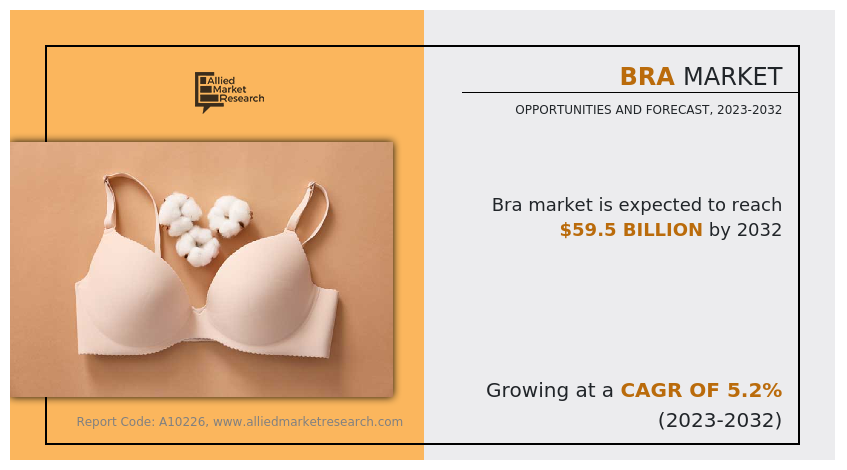Bra Market Research, 2032
The global bra market size was valued at $36.3 billion in 2022, and is projected to reach $59.5 billion by 2032, growing at a CAGR of 5.2% from 2023 to 2032. A bra is a form-fitting undergarment that women wear under their other clothes to support their breasts. Bra helps to support, and maintain shape and volume of breasts. It provides comfort and support while performing exercise and physical activities. Bra is generally considered in various categories such as sports, nursing, multi-way, adhesive, and others. Bra serves as the key fashion accessory, which allows women to express personal style and preferences through various designs, colors, and patterns.
Market Dynamics
The ever-changing preferences of consumers and fashion trends have had a significant impact on the bra industry. The market for intimate clothing reacts quickly to shifts in style, with buyers looking for bras that fit the newest styles. Consumer preferences for various styles, colors, and designs of undergarments change along with fashion, which propels the expansion of the bra market. Furthermore, customers are always looking for innovative and distinctive bras that not only offer necessary support but also showcase their personal style and fashion sense.
Moreover, consumers frequently look for bras as stylish accessories that highlight the value of aesthetics and individuality. Bra market statistics reveal a dynamic industry which reflects evolving fashion trends, changing consumer preferences, and the continual innovation of intimate apparel designs.
Manufacturers have expanded the range of items they sell in response to the shift in consumer expectations, bringing in a variety of styles such sports bras, bralettes, and personalized designs. Social media platforms are becoming increasingly popular, making it simpler to identify fashion trends and keeping consumers informed and encouraged. Furthermore, celebrities and influencers have a big influence on the fashion business, which fuels the need for bras along with the latest fashion trends through their influence on lingerie trends.
The growing need for eco-friendly fabrics and cutting-edge fabric technologies has caused immense change in the bra market demand. The use of sustainable and eco-friendly materials in bras is growing as the significance of the environment continues to evolve consumer preferences. Increase in demand for ethical and ecological design from consumers is driving producers to look for alternative materials for bra production, such as organic cotton, recycled fibers, and bamboo fabric.
In addition, the bra industry has benefited from advances in fabric technology brought about by the goal of comfort and practicality. Innovative materials, which respond to changing consumer requirements, such as breathable textiles, seamless structures, and moisture-wicking fabrics, are becoming increasingly popular. By improving bras' overall performance and offering better comfort, support, and durability, the use of these technologies helps the bra industry to expand. Furthermore, putting an emphasis on sustainability and innovation not only satisfies consumer desire for undergarments made ethically but also expands the market by drawing in a varied customer base that is looking for bras that combine environmental responsibility with fashion.
The industry's capacity to smoothly satisfy customer demand is being impacted by the bra market's significant supply chain challenges. The intimate clothing industry is dependent on an intricate global supply chain that includes the procurement of raw materials, production, and delivery. Disruptions in the supply chain might lead to a shortage of necessary materials for the production of bras, which would impact the manufacturing process as a whole.
Moreover, supply chain disruptions brought on by natural catastrophes, geopolitical unrest, or global health emergencies may result in shortages, order delays, and higher production prices for bras, which would restrict the market growth. In addition, fluctuations in the price of materials may force bra manufacturers to increase their costs or compromise on quality, which might hurt their ability to compete in the market and please customers.
Furthermore, inventory problems brought on by production and delivery delays might hinder the market growth by causing shops to experience stockouts or overstock situations.
The adoption of eco-friendly and sustainable initiatives, which represents a broader shift in consumer perceptions toward moral and environmentally responsible choices, presents the bra industry with huge growth potential. Customers are actively looking for bra and lingerie manufacturers that value sustainability in their manufacturing processes and materials as a result of growing awareness of the negative environmental effects of fashion.
Moreover, this trend has created opportunities for innovation and encouraged the creation of environmentally acceptable substitutes such as organic fabrics and recycled materials for bras. Sustainable brands appeal to an increasing number of socially aware consumers while also helping to preserve the environment.
Bra manufacturing companies can stand out in a competitive market and maintain customer loyalty by introducing eco-friendly initiatives like cutting down on carbon footprints, conserving water, and supporting ethical labor practices. Adopting sustainable methods also complies with industry and governmental requirements meant to lessen the fashion sector's environmental impact.
Segmental Overview
The bra market is segmented into type, raw material, distribution channel, and region. By type, the market is classified into sports bra, nursing bra, multi-way bra, and adhesive bra. By raw material, the market is classified into cotton, chiffon, silk, and others. By distribution channel, the market is classified into hypermarket/supermarket, specialty stores, retail stores, and online.
Region-wise, the market is analyzed across North America (the U.S., Canada, and Mexico), Europe (France, Germany, the UK, Italy, Spain, Russia, and the Rest of Europe), Asia-Pacific (China, Japan, India, Australia, South Korea, ASEAN, and the rest of Asia-Pacific), and LAMEA (Brazil, Argentina, South Africa, the Middle East, and the rest of LAMEA).
By Product Type
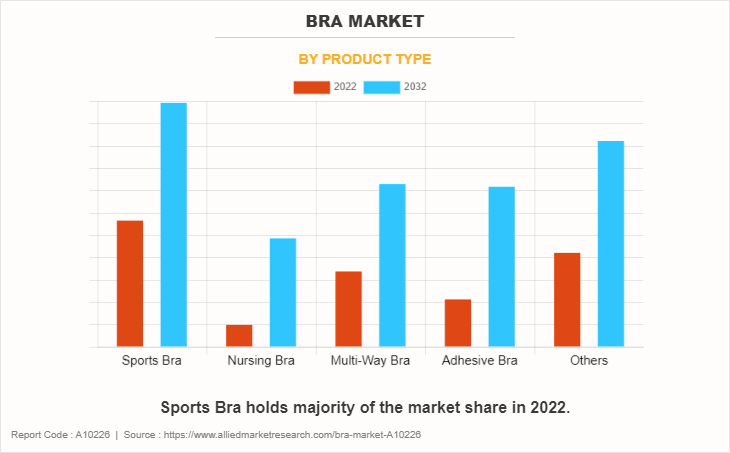
According to product type, sports bra segment dominated the market in the year 2022 and is expected to maintain its trend during the bra market forecast period. As more women embrace active lifestyles, there is a growing demand for specialized bras that provide superior support and comfort during physical activities. Sports bras are designed with features like moisture-wicking fabrics, compression support, and reduced bounce which address the unique needs of active women. The athleisure trend has led to sports bras being worn during workouts and also as everyday apparel. This dual functionality has significantly expanded the consumer base for sports bras, contributing to their majority share in the bra market growth.
By Raw Material
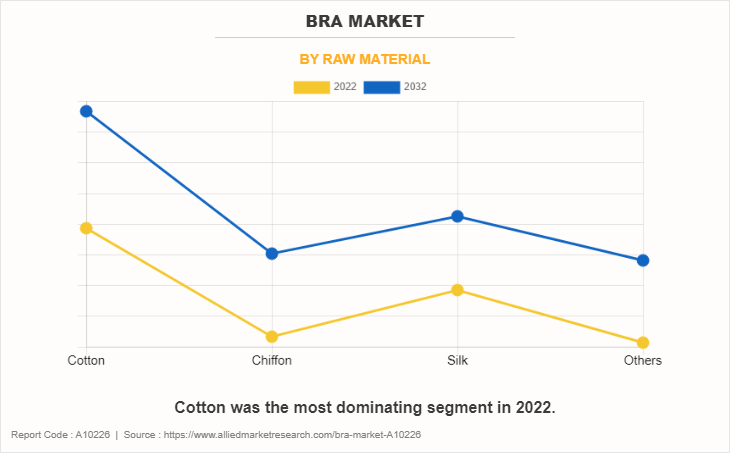
According to raw material, cotton segment dominated the market in the year 2022 and is expected to maintain its trend during the forecast period. The breathable nature of cotton fabric makes it ideal for everyday wear, providing comfort throughout the day. cotton bras are well-suited for various climates, offering a cooling effect in warmer temperatures. The widespread popularity of cotton bras is attributed to their comfort-focused design which meets the preferences of a broad consumer base.
By Distribution Channel
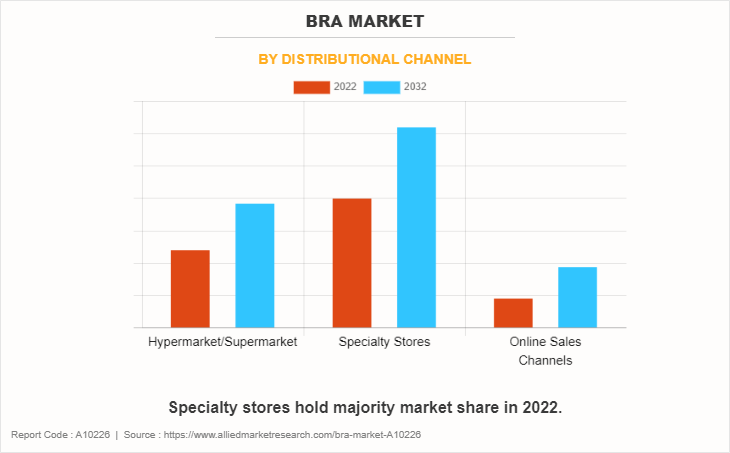
According to the distribution channel, specialty stores dominated the market in the year 2022 and are expected to maintain their trend during the forecast period. Specialty stores specializing in lingerie products such as bra provide a dedicated shopping experience which allows the customers to receive personalized fittings and advice from knowledgeable staff. Moreover, specialty stores often carry a wide selection of brands, styles, and sizes that cater to the diverse preferences and body types of consumers.
By Region
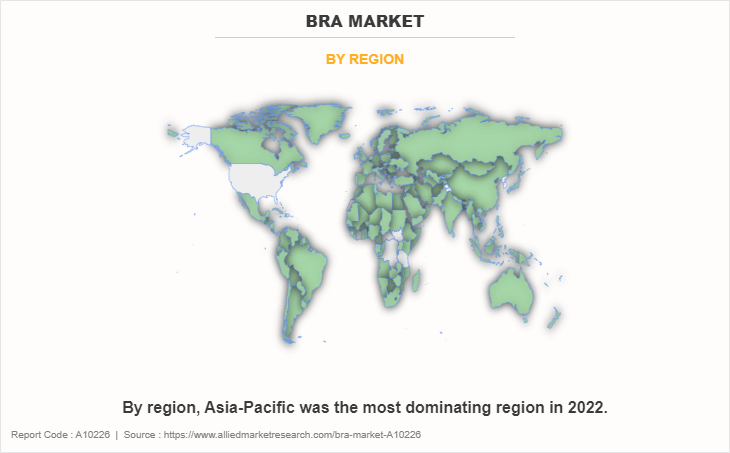
Depending on region, Asia-Pacific dominated the bra market in 2022 and is expected to be dominant during the forecast period. With a significant percentage of the world's population, the Asia-Pacific region represents a vast consumer base for intimate apparel products including bras. As economies in countries like China and India continue to grow, there is an increasing disposable income which allows consumers to spend more on clothing and lingerie.
Competition Analysis
Players operating in the global bra market have adopted various developmental strategies to expand their bra market share, increase profitability, and remain competitive in the market. Key players profiled in this report include PVH Corp., Nike, Inc., Hanesbrands Inc., Jockey International, Inc, CALIDA Holding AG, Lavinia Lingerie Inc, Victoria's Secret & Co., Triumph Intertrade AG, Wolf Lingerie SAS and Modenik Lifestyle Pvt. Ltd.
Some Instances of Key Develpoment in The Market
In August 2022, Jockey International, Inc. announced a multi-year partnership with Parkside which includes collaboration on facilities, athletics, career services, and community engagement initiatives.
In May 2022, Calida Holding AG has acquired American premium lingerie and loungewear brand Cosabella to further strengthen the CALIDA Group position in its core segment of underwear and lingerie in U.S. market.
Key Benefits For Stakeholders
This report provides a quantitative analysis of the market segments, current trends, estimations, and dynamics of the bra market analysis from 2022 to 2032 to identify the prevailing bra market opportunities.
The market research is offered along with information related to key drivers, restraints, and opportunities.
Porter's five forces analysis highlights the potency of buyers and suppliers to enable stakeholders make profit-oriented business decisions and strengthen their supplier-buyer network.
In-depth analysis of the bra market segmentation assists to determine the prevailing market opportunities.
Major countries in each region are mapped according to their revenue contribution to the global market.
Market player positioning facilitates benchmarking and provides a clear understanding of the present position of the market players.
The report includes the analysis of the regional as well as global bra market trends, key players, market segments, application areas, and market growth strategies.
Bra Market Report Highlights
| Aspects | Details |
| Forecast period | 2022 - 2032 |
| Report Pages | 274 |
| By Product Type |
|
| By Raw material |
|
| By Distributional channel |
|
| By Region |
|
| Key Market Players | Nike, Inc., Modenik Lifestyle Pvt. Ltd., Calida Holding AG, Lavinia Lingerie Inc., PVH Corp., Triumph Intertrade AG, Victoria's Secret & Co., Jockey International, Inc., Hanesbrands Inc., Wolf Lingerie SAS |
Analyst Review
According to CXOs of leading companies, the global bra market is emerging at a considerable pace, owing to several factors such as rise in demand for new and innovative fashion trends. Individuals in developed nations, especially women monitor their individual fashion trends and make consistent efforts in purchasing different types of bra. Increasing population globally and rise in usage of sustainable materials and innovative fabrics by bra manufacturing companies, draw consumers attention toward purchasing bra. All these factors drive the growth in sales of the bra market.
Furthermore, significant shifts in consumer behavior have led to a greater need for bras, as when renowned individuals or celebrities particularly endorse a certain bra brand or style, it often generates more demand and credibility. As a result, most women are ready to spend more money on stylish and high-quality bras. Thus, the demand for bras is projected to rise on a global level. Moreover, for the single-line product area, multi-brand specialty stores carry a variety of brands so that customers may evaluate their features and colors before making a purchase.
The bra market growth has witnessed a significant transformation as a result of the increase in demand for eco-friendly materials and innovative fabric technologies.
Asia-Pacific region accounted for the largest bra market share.
Key players profiled in this report include PVH Corp., Nike, Inc., Hanesbrands Inc., Jockey International, Inc, CALIDA Holding AG, Lavinia Lingerie Inc, Victoria’s Secret & Co., Triumph Intertrade AG, Wolf Lingerie SAS and Modenik Lifestyle Pvt. Ltd.
The global bra market to register at a CAGR of 5.2%.
The global bra market was valued at $ 36,306.2 million in 2022, and is projected to reach $ 59,471.1 million by 2032, registering a CAGR of 5.2%.
Loading Table Of Content...
Loading Research Methodology...

